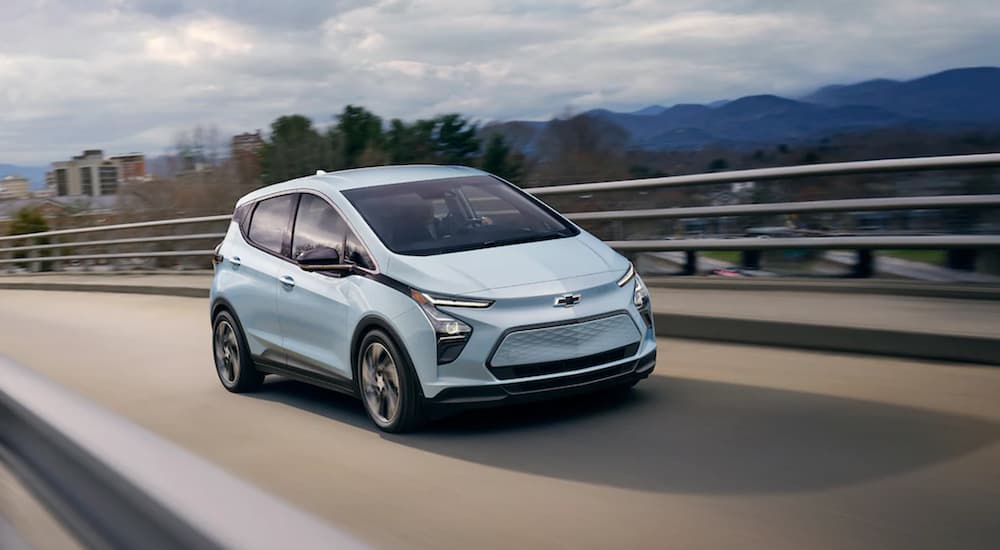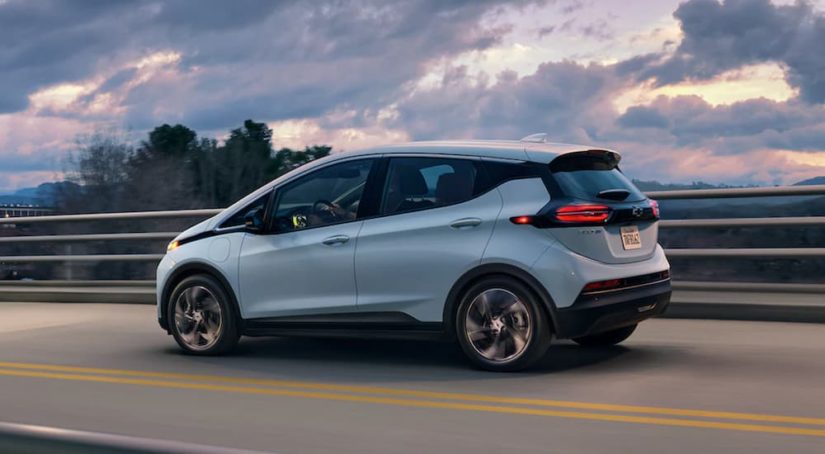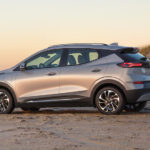Are you on the cusp of going electric? Sifting through the volumes of electric vehicle (EV) news and reviews coming from the auto industry is a little overwhelming even for enthusiasts. That’s because all the major manufacturers are announcing bold plans to electrify their lineups in an effort to combat the effects of greenhouse gases on climate change. Exemplifying this effort is General Motors’ release of the 2022 Chevy Bolt EV.
The Bolt EV reinvents what it means to be a commuter car. It used to be that buying an EV involved comparing your preferred model with other EVs to come to a decision, but the Bolt EV is so similar in price and performance to its gas-powered counterparts that it deserves consideration even if buying an EV wasn’t originally on your radar. In other words, you can think of the Bolt EV as a compact hatchback that just happens to be electric, especially when comparing price and performance.
Chevy hopes the Bolt EV is just the beginning of a paradigm shift in the industry as a whole. It and other global manufacturers are prioritizing battery-powered vehicle production and materials sourcing, including creating manufacturing economies-of-scale, which means EV prices continue to trend down. Add to that a cheaper cost-of-ownership and fewer maintenance requirements, and buying an EV quickly becomes a no-brainer, especially for commuters.
Bolt EV Performance and Driving Range
The number one barrier for would-be EV buyers is driving range. Early EVs struggled to offer more than double-digit mileage ranges, but the Bolt EV represents the new generation, offering a range of up to 259 miles on a single charge. GM has worked hard to make charging easy by supporting a nationwide effort to expand charging station availability, as well as covering the cost of installing a Level 2 charging outlet in your garage. For 2022, the speedier DC Fast Charging system is standard on all Bolt EV models.
Tracking the Bolt EV’s charging level and mileage remaining is seamless with Chevy’s integrated driver information center on the dash. This quick-glance display helps you keep track of the distance remaining and other vehicle diagnostic data. The companion myChevy app takes that data a step further, analyzing exterior temperature, current driving conditions, and other variable data to calculate the actual range. It can also locate nearby charging stations and estimate the time it will take to fully recharge the vehicle.
Even if they’re sold on driving range, buyers often abandon the idea of going electric for fear of lost performance. We can blame the early EV models for this lingering concern since most offered humdrum acceleration and uninspiring overall performance ratings. The 2022 Bolt EV flips the script, with a 0-to-60 time of just 6.5 seconds and an available Sport Mode that adapts the gear ratios and available torque to deliver more performance-oriented driving characteristics.
Unique to EVs is One Pedal Driving, a feature that utilizes regenerative braking to slow down. It’s accomplished by using only the accelerator pedal for adjusting speed (not the brakes), and it’s capable of bringing the Bolt EV to a complete stop. This one pedal arrangement also captures energy and contributes to battery recharging while the vehicle is being driven. Coupled with the instant torque found only on EVs, it’s a surprisingly spirited driving experience.

Interior Cabin Comfort and Features
When it comes to comfort and convenience features, the 2022 Chevy Bolt EV doesn’t disappoint. Slide behind the driver’s seat for your morning commute, and you’re greeted by a 10.2-inch HD infotainment touchscreen with crisp HD graphics and a user-friendly interface that lets you stream your favorite podcast or playlist with a simple touch command. The system is wirelessly compatible with Apple CarPlay and Android Auto for seamless smartphone integration.
Also available on select Bolt EV models is an optional Infotainment Package, which adds a premium 7-speaker Bose audio system with a built-in subwoofer, a wireless charger, and an extra two charging ports in the back for rear-seat passengers. Buyers of the base 1LT trim can opt for the available Comfort and Convenience Package to add heated front seats, an automatic heated leather-wrapped steering wheel, and a handy auto-dimming rearview mirror.
The slightly more expensive 2LT trim includes standard leather seating surfaces and Chevy Safety Assist, a suite of semi-autonomous driver-assist systems that use a series of sensors, radar, and cameras to keep occupants safer while on the road. The suite includes Automatic Emergency Braking, Forward Collision Alert, Front Pedestrian Braking, Following Distance Indicator, Lane Keep Assist with Lane Departure Warning, and IntelliBeam Automatic High Beams.
Chevy’s lightning-fast Infotainment 3 Plus System powers the touchscreen, making accessing apps and other smartphone content quick and easy. The system features voice recognition and the ability to pass voice commands directly to your device. All Bolt EVs come standard with a SiriusXM satellite radio trial subscription which integrates with Chevy’s connected services to offer app-based features like remote start, remote lock/unlock, and vehicle locator capabilities.
A Closer Look at EV Ownership
If you’re a commuter, you probably work a full-time job that makes carving out time for service next to impossible. When you buy an EV, the concept of routine maintenance shifts dramatically. Without an engine, you can say goodbye to oil changes and various other fluid replacements, like coolant, which eliminates that pesky 5,000-mile service visit requirement. EVs aren’t entirely without maintenance requirements, but they’re far simpler and fewer in number.
Another great EV benefit is the relative cost of “fuel.” The average cost for a gallon of gas is around $2.95, so for a gas-powered car equipped with a 10-gallon tank that achieves around 30 MPG of fuel economy (the rough average MPG of most subcompact cars), you’ll pay approximately $30 for a tank of gas and get about 300 miles per tank.
Conversely, electricity costs about .14 per kWh and takes about 7 kWh/hour to charge, so it will cost you roughly $6.86 to drive 259 miles. Chevy offers a handy savings calculator on its Living Electric page to further illustrate the savings. When compared with a similarly-sized 32 MPG gas-powered vehicle, if you drive 30,000 miles for five years, you can expect to save nearly $7,500 in ownership costs.
Chevy puts its money where its mouth is by offering Bolt EV customers an 8-year/100,000-mile electric component warranty on top of its already robust factory warranty program. In addition, owners have access to a dedicated call center filled with EV experts who are trained to answer questions, troubleshoot, or offer support as drivers transition into electric vehicle ownership.

It’s Time to Change Up Your Commute
Upon closer inspection, electric vehicles are ideally suited for commuting, especially when compared with a gas or hybrid-powered alternative. The Bolt EV, in particular, offers a class-leading list of performance and economic benefits, starting with its long range and culminating in significant cost savings throughout the ownership period. Let’s also not forget the environmental benefits of driving a zero-emissions vehicle.
Priced at just over $31,000 and topping off near the mid-$30,000 range, the 2022 Bolt EV is aligned with other cars in its class. Gone are the days when EV buyers had to absorb manufacturing costs in the sticker price and wait five years to see any actual cost savings. Instead, EVs like the Bolt EV start off affordable. Add the low cost of ownership and absence of compromise from a performance perspective, and it’s easy to see how the Bolt EV is revolutionizing the commute.



